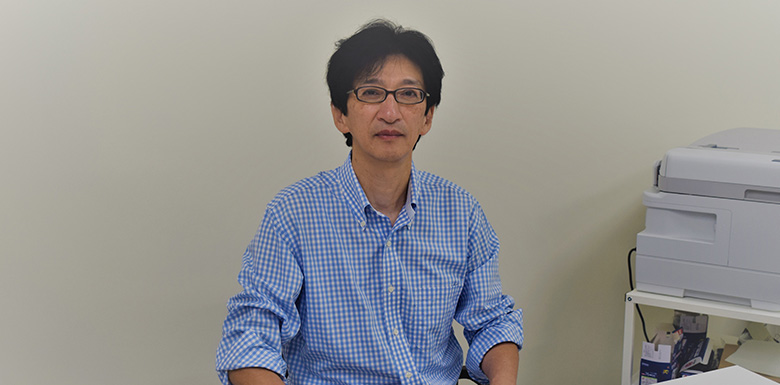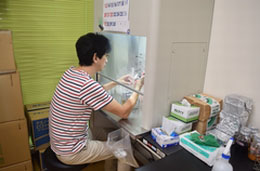"In search of new possibilities for lactic acid bacteria" - Takehisa Kumagai (Food Processing, Food Science, Food Microbiology)

Plant-derived lactic acid bacteria have long been skillfully used in the Japanese diet. One typical example is nukazuke: fermenting vegetables in rice bran (nuka). Nowadays, yogurt made from animal-derived lactic acid bacteria is also common, and very useful for maintaining one's health. In this lab visit, we talked with Professor Takehisa Kumagai of the Faculty of Food and Agricultural Sciences, who studies plant-derived lactic acid bacteria.
Professor Kumagai's research
Q: Can you please tell us about your research?
A: I am researching plant-derived lactic acid bacteria. Specifically, I isolate lactic acid bacteria from sake lees (the pressed rice mash that's left over at the end of the sake brewing process) produced in Fukushima Prefecture and select excellent strains that are suitable for health functions and food processing.
Q: What made you decide to start this kind of research?
A: It is said that yogurt made from animal-derived lactic acid bacteria became widespread in Japan in the Showa era. Long before that, some members of the nobility ate "daigo," a processed milk product, but it seems that ordinary people could not get this. However, it is said that plant-derived lactic acid bacteria have been eaten in Japan for centuries. It's like grandma's wisdom: If you add water and salt to rice bran, yeast and lactic acid bacteria spring up and you can make delicious nukazuke rice bran pickles. Polished rice and brown rice are full of microorganisms. Natto bacteria clings to straw. Japanese have found clever ways to use the microorganisms attached to grains and the like. This shows that Japanese have a strong affinity for plant-derived lactic acid bacteria in their diet. I thought this historical background would provide a rich area for research. Also, many major dairy product producers are conducting research on lactic acid bacteria derived from milk, intestines, and feces, so I thought why not isolate lactic acid bacteria from plants and fermented vegetable matter to use for health purposes?
Q: What kind of difficulties have you run into in your research on lactic acid bacteria?
A: The hardest part is choosing which bacteria to advance to the stage of human testing. Testing in test tubes can be redone to some extent, but there's a limit to how much testing can be done on humans. So the scariest decision is the one where you say, "This is it! This is the one we'll test on humans." And then, of course, waiting for the results, after conducting the tests, is very suspenseful. I'd say that's the most difficult part, the biggest hurdle that has to be overcome.
Q: Have you wanted to do this kind of research ever since you were a student?
A: No. When I was a student, I was in a microbiology laboratory and was doing research on filamentous fungi (molds), but when I got a job, I stopped researching microorganisms. Then, when I was about 30 years old, it occurred to me that it would be interesting to do something with rice lactic acid bacteria. I consulted with my boss at the time, and the result was that I began studying lactic acid bacteria. From my eating experience, I knew that nukazuke pickles are made using rice bran, so I thought, "Maybe there are similar uses for lactic acid bacteria." I had discontinued my research on microorganisms, but the foundation was still there, so I decided "Let's try something new. Let's aim a bit higher and dream!" That's how I began this research.
Q: Lactic acid bacteria are getting a lot of attention these days.
A: That's because bacteria with new uses are being discovered. Lactic acid bacteria can perform many functions, such as reducing body fat and adjusting the condition of the stomach.The market is expanding, and market size and research are linked.
Q: Do you eat or drink lactic acid bacteria every day?
A: I eat yogurt. This is a little off-topic, but are you familiar with the "hygiene hypothesis?" It hasn't been entirely verified, but the idea is that the world has become so clean and we have become so careful about hygiene that we no longer ingest various microorganisms, and this has had the effect of lowering our intestinal immunity and increasing allergies. Nowadays, with measures that are being taken to prevent infection with the novel coronavirus, we have become even more careful about cleanliness. As hay fever and other allergies continue to increase, I think the role of lactic acid bacteria will become more and more important.
Q: Do you mean that lactic acid bacteria also have the effect of suppressing allergies?
A: Yes, certain strains do.
Q: Certain strains?
A: Yes. In my previous job, I selected two such strains out of hundreds. One is a lactic acid bacterium that has a beneficial effect on the stomach and the skin, and the other is a lactic acid bacterium that is effective in controlling allergies such as atopic dermatitis and hay fever. I think the market for lactic acid bacteria will continue to be strong, as different strains have various different properties. There is still plenty of room for research.

